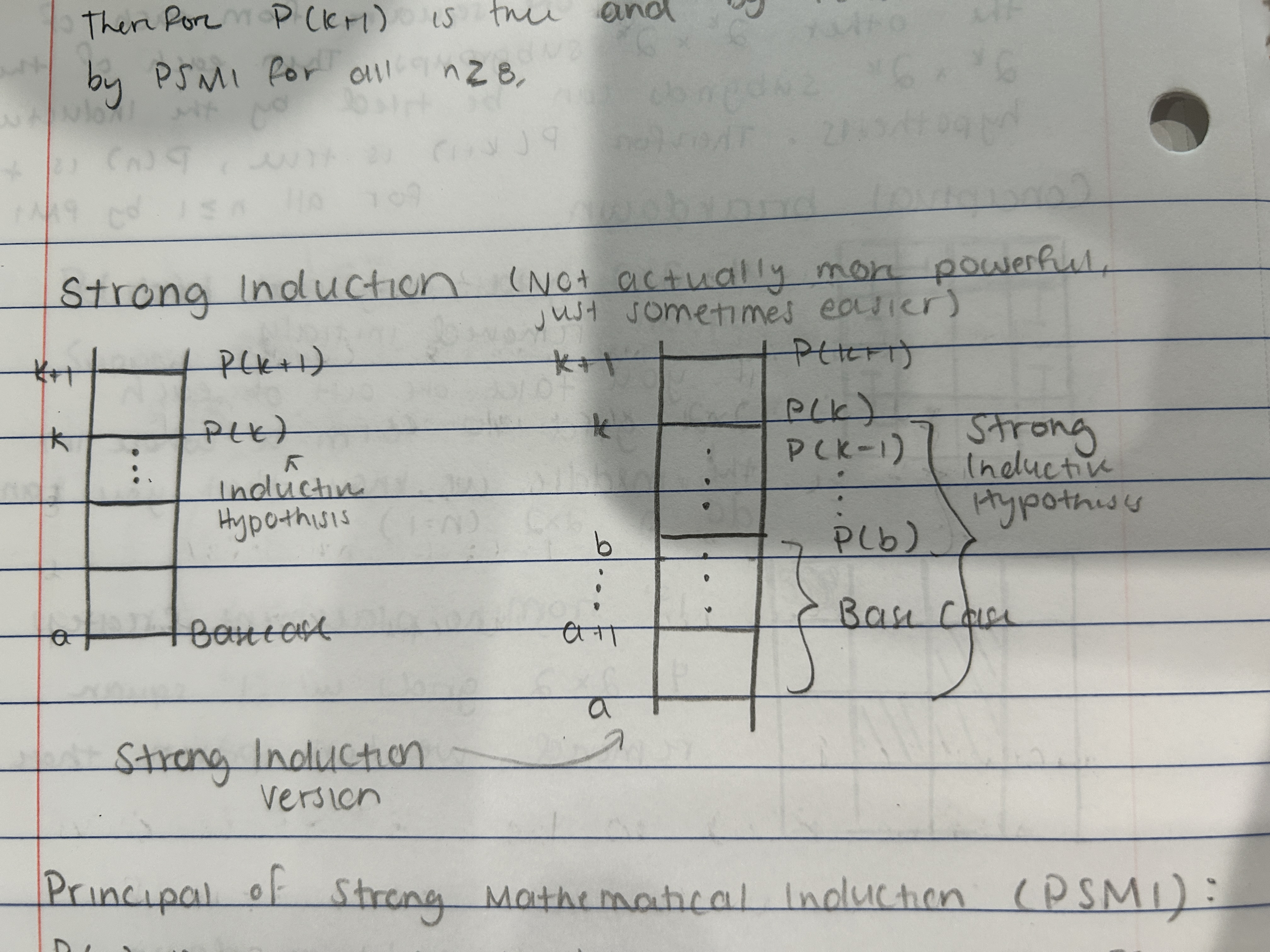Discrete Structures Exam 3
1/26
Earn XP
Description and Tags
Graphs and Induction
Name | Mastery | Learn | Test | Matching | Spaced |
|---|
No study sessions yet.
27 Terms
Formal Definition of a Graph
A collection of points connected by edges
Undirected graphs
Edges that connect to their vertices in both directions
Connected Graphs
For any two vertices in the graph, there is a path that connects them
How do you know when a directed graph is connected?
When the same graph, viewed as undirected, is connected
What is the degree of a vertex? What are the special descriptions for degrees of vertices in directed graphs?
The number of edges that are adjacent to the vertex, and vertices in a directed graphs can have an “in-degree” for the number of edges going out and an “out-degree” for a number of edges going in.
Definition of a loop
An edge from a vertex to itself
Definition of a subgraph
Let G = (V, E). If there exists a V’ and an E’ such that V’ is a subset of V and E’ is a subset of E, then G’ = (V’, E’) is defined as a subgraph of G
Definition of an induced subgraph
Let G = (V, E) and V’ be a subset of V. Let E’ be all the edges of E that only touch vertices in V’. Then, G’ = (V’, E’) is an induced subgraph of G, aka the subgraph induced by V’.
Definition of a Clique
A type of subgraph where every two vertices are connected by an edge, not a path
Definition of a walk
Let x, y be in V; a walk (or a path) from x to y is a sequence of vertices denoted by
x = x_0, x_1, x_2, …, x_k = y, where x_0 = x and x_k = y
such that (x_i, x_i+1 are in E) for i = 0, …, k-1
What is length of a walk equivalent to?
The number of edges between the vertices on the walk
What is one graph that is always found in the subgraphs of a graph?
The empty graph
Definition of a complete graph
When every vertex in a graph is connected to every other vertex with an edge;
For every vertex v_i in V, there exists an edge (v, v_k) where k does not equal i in E
When is a graph planar?
When it can be drawn in two-dimensions without any edges crossing
What is the maximum number of edges a planar graph can have when n>=3? (Theorem)
A planar graph with n>=3 edges can have at most 3n-6 edges
Definition of a simple circuit/cycle
A simple circuit starting at x in V is a sequence of vertices
x = x_0, x_1, …, x_k = x such that (x_i, x_i+1) in E for all i = 0, 1, 2, …, k-1
and x_i does not equal x_j except for x_0 = x = x_k
“It does not cross itself/repeat vertices”
Definition of a Hamiltonian Circuit
A simple circuit that visits each vertex in G exactly once
Definition of a Hamiltonian Graph
A graph that contains a Hamiltonian circuit
How do you know if a complete graph is Hamiltonian?
When it has n>=3
Definition of a bipartite graph
Given G = (V, E), if V can be divided into groups U and W such that:
For every u in U, there exists an edge (u, w) where w is in W
For every edge (u, x) where u in U, x is not in U
For every edge (w, x) where w in W, x not in W
Theorem connecting simple circuits, planar graphs, and max number of edges
Let L be the length of the shortest simple circuit in G. If 3 <= L <= infinity, then G has at most
max{(L/L-2) * (n - 2), n - 1} edges
How can you find the number of walks between two vertices (i, j) with a specific length?
Raise the adjacency matrix to the nth power and view the (i, j) position in the matrix
Formal and Informal Definition of a Sequence
Formal: A function from a range of the set of all integers to a set of objects
Informal: An ordered list of objects/elements/terms
Can sequences have repeated elements?
Yes
When a problem asks for an explicit definition of a sequence, what is it asking for?
A formula, sometimes with bounds (example, the sequence of positive even numbers can be defined as e_k = 2k where k > 0)
Properties of Summations
Let m <= n. Given two sequences a_i and b_i that start at m and end at n:
The separate summations added together equals the summation of a_i + b_i
A scalar constant can be inside or outside the summation
The product of two product summations of a_i and b_i equals the product summation of a_i * b_i
Go draw the ladder for induction vs strong induction and what terms are included in the inductive hypothesis
